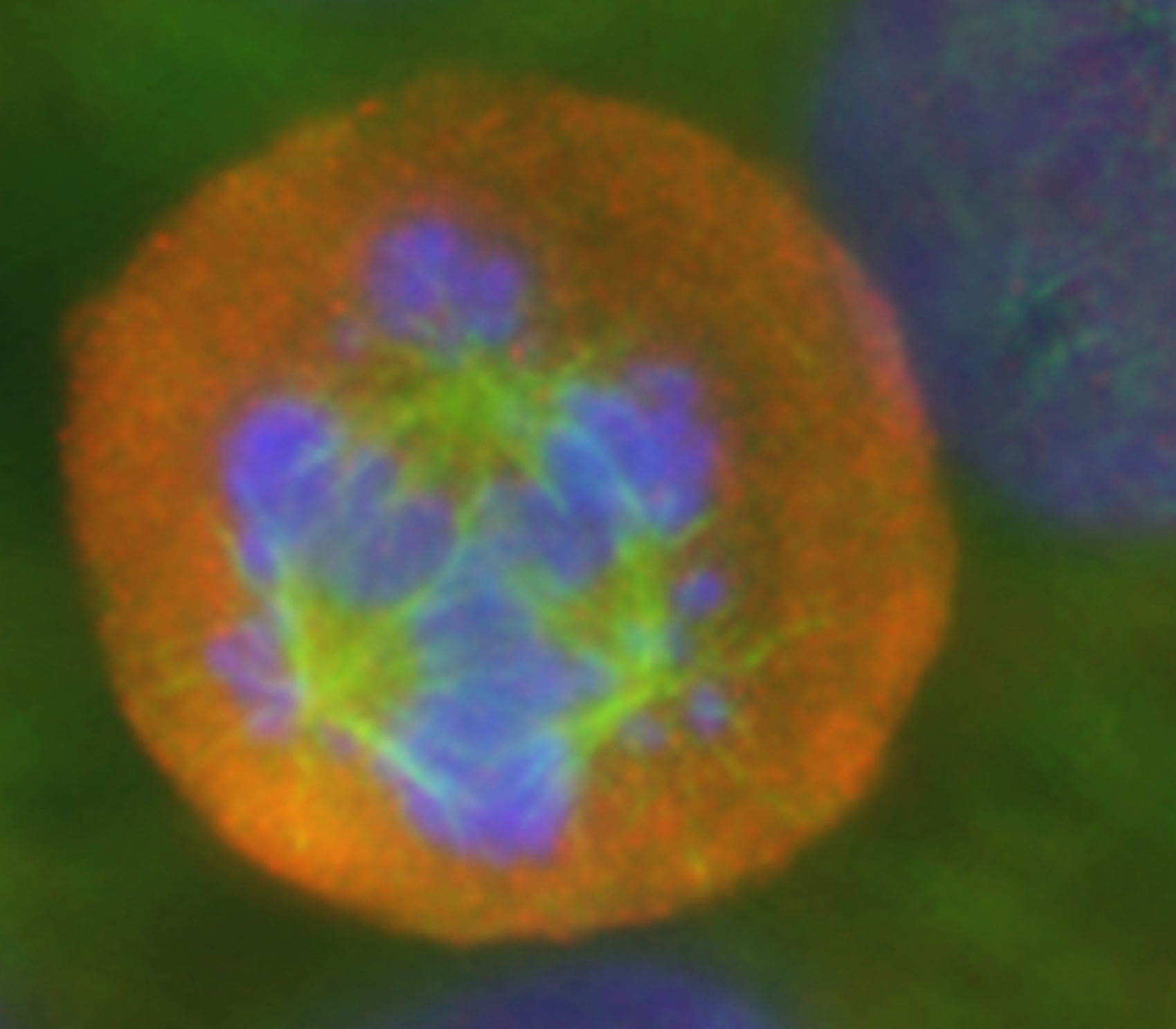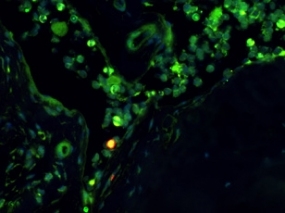Cancer – basic research, successes and trends
Science is approaching cancer treatment by using new systems biology approaches and setting up large-scale multidisciplinary projects such as the International Cancer Genome Consortium. Progress in genome, epigenome and gene expression analyses of cancer cells, new insights into the regulation and interaction of cells gained in cooperation with stem cell research and virus research contributes to gaining a causal understanding of cancer. This increases the chances of being able to cure cancer.
In late 2011, the journal Science published an editorial with an outlook on cancer research entitled “The year they crack cancer?” The title ended in a precautionary question mark, and the author of the article was at pains to explain that he did not mean that 2012 would be the year that cancer is definitively cured. What he wanted to communicate was that researchers are still a long way from being able to cure cancer, but that a breakthrough in understanding the development, growth and spread of cancer could be possible, which would bring the possibility of curing cancer much closer.
The genome, epigenome and transcriptome of tumours
 Multipolar, malformed spindle of a cancer cell © German Cancer Research Center (DKFZ)
Multipolar, malformed spindle of a cancer cell © German Cancer Research Center (DKFZ)What prompts the most renowned American science journal to be so optimistic, even though the statement it made is likely to raise expectations for cancer patients that will remain unfulfilled? Is it the decisive advances in understanding the pathogenesis of cancer that are expected from results obtained by the International Cancer Genome Consortium (ICGC), a group of gene-sequencing laboratories from 22 countries that plans to analyse several hundred samples from the 50 most important tumour types and compare them with each other and with healthy tissue from patients’ other organs?
Cancer is a disease of the genome, and there are many different types of cancer. Some tumours have thousands of different mutations. The problem lies in the identification of the genes relevant for the disease. The ICGC also focuses on epigenetic alterations, i.e. alterations that are not encoded in the DNA sequence, and the cancer transcriptome (the expression of genes). The German contributions to this huge research project are pooled in the “PedBrainTumor” research project which is coordinated by the German Cancer Research Center (DKFZ) and focuses on paediatric brain tumours. Outside the ICGC, genetic and epigenetic analyses of different tumours – breast, colon, liver and prostate cancer, for example – are also the focus of oncological research at Baden-Württemberg universities.
It is expected that in a few years’ time genetic and epigenetic data will be collected by central institutions such as the National Centre for Tumour Diseases (NCT) with the aim of enabling effective cancer diagnosis and optimal therapy. New classification schemes based on the combination of molecular and clinical data, have recently been presented for tumours such as glioblastomas. It can be safely assumed that it will soon be possible to comprehensively classify all tumours based on their mutations and genetic mechanisms rather than on their origin in the tissue, as has been the case up until now. Oncologists hope that this knowledge will help them reduce or even completely eliminate uncertainties related to prognosis and therapy decisions, something that has been inevitable due to the bewildering variety in the development and aggressiveness of tumours that appear to be the same type.
Tumour stem cells, tumour viruses and cell-cell interactions
 Cancer stem cells are a highly topical theme in cancer research (the photo shows a stem cell labelled orange in the bone marrow) © German Cancer Research Center (DKFZ)
Cancer stem cells are a highly topical theme in cancer research (the photo shows a stem cell labelled orange in the bone marrow) © German Cancer Research Center (DKFZ)Tumour stem cells are another major current issue in cancer research. Tumour stem cells are part of a tiny, very resistant cell population found within the large mass of cancer cells. Tumour stem cells give rise to all cell types in a particular sample and keep the tumour alive. The existence of tumour stem cells has long been more a hypothesis than a fact, but progress made in cancer research has substantiated the hypothesis for many types of cancers. The mechanisms used by tumour stem cells to become resistant to chemo- and radiotherapy, i.e. the interaction with components in the environment of their “stem cell niche”, and the ways used to drag them out of their niche and destroy them, are two of the most fascinating and promising areas in state-of-the-art cancer research. The greatest progress has been achieved for leukaemias (blood cancer).
The discovery of microRNAs as regulatory elements of gene expression has provided cancer researchers with effective instruments to experimentally modulate the growth of tumour cells. microRNAs are also important tools for the diagnosis of cancer diseases. However, it is not yet known whether microRNAs can also be used for the treatment of cancer. The German Consortium for Translational Cancer Research (DKTK), a partnership of the German Cancer Research Center (DKFZ), the NCT and leading clinical partners from all over Germany (including the tumour centres in Freiburg and Tübingen), was established in 2012 with the goal to translate current research results swiftly into clinical practice. The discovery of tumour viruses as the causes of cervical cancer, a discovery that was awarded the Nobel Prize in Medicine or Physiology in 2008, and the development of an effective vaccine against this cancer, are paradigm examples of the transfer of research results into clinical practice. Intensive research over the last few years has also identified viruses as the causes of other tumours.
In their endeavour to understand the pathogenesis, course and therapy of cancer, researchers also need to take into account the interactions of tumour cells with each other and with other cells as well as with body structures such as connective tissue, the extracellular matrix and blood vessels. Using three-dimensional tumour models in tissue cultures, computer simulations and systems biology approaches, researchers are collecting information about the complex interactions with the aim of making predictions on therapeutic outcomes. The trend is therefore moving towards collaborative work in multidisciplinary cooperative research projects such as the ones that are being funded under the German FORSYS – Research Units of Systems Biology funding initiative.
Increase in the incidence of cancer, but better chances of survival
 The incidence of liver cancer is on the increase in Germany, most likely due to hepatitis C infections. Source: Public Domain I Ed Uthman I Wikipedia
The incidence of liver cancer is on the increase in Germany, most likely due to hepatitis C infections. Source: Public Domain I Ed Uthman I WikipediaInformation obtained about the causes of cancer using innovative research approaches has not yet led to an increased possibility of curing cancer; there has not yet been sufficient time to develop effective cancer diagnosis and treatment methods. However, epidemiological studies have shown that excellent progress has been made for some types of cancers, although unfortunately not for all. On the other hand, the prevalence of cancer in Germany is on the increase; the Robert Koch Institute predicts that around 490,000 people will be diagnosed with cancer in 2012, compared to 400,000 around 10 years ago. The increase in cancer is mainly due to demographic changes: there is an increased risk of cancer in old age; ageing processes and cancer have common aspects that are the subject of intensive studies. On one hand, the observed increase in cancer prevalence is due to an improved collection of data in cancer registers; on the other hand, it is down to more effective screening methods, including for example methods that enable the early diagnosis of breast and skin cancer. The increase in lung cancer among women is probably due to the fact that the number of women who smoke has increased significantly over the last few decades, while the number of male smokers has decreased. This has led to a lower number of lung cancer-related deaths overall. However, incidence and mortality rates for men are still twice those of women.
Progress made in the identification of early cancer stages has made significant contributions to increasing the survival rate of cancer patients. At present, fewer than 50% of all cancer patients die of cancer, compared to two thirds thirty years ago. The major reason for the increase in cancer survival rates is the progress made in cancer treatment: personalised medicine enables drugs and treatment strategies to be adapted to the requirements of individual patients; in addition, technological progress has made traditional methods such as chemo- and radiotherapy more accurate and specific (see BIOPRO dossier “Cancer therapy and diagnostics”). It is these less spectacular advances made in cancer medicine that gives cancer patients hope, even though the big breakthrough projected by the Science editorial might still be a long way off.